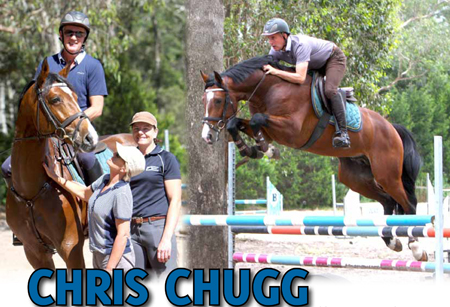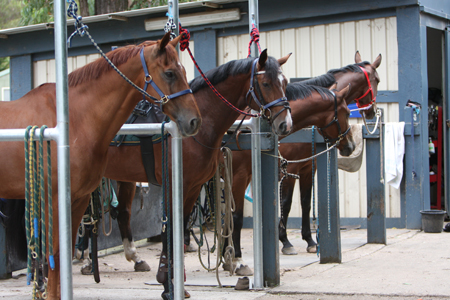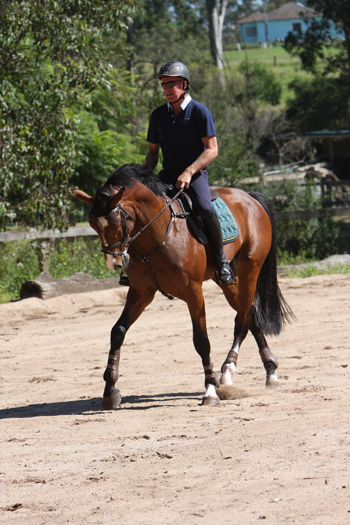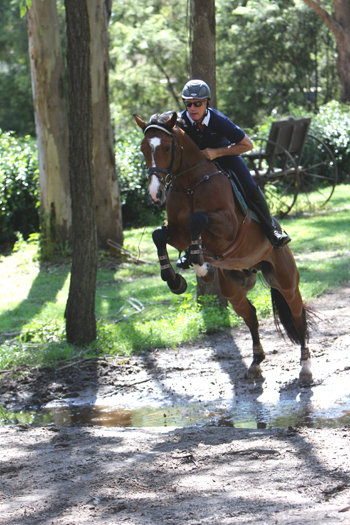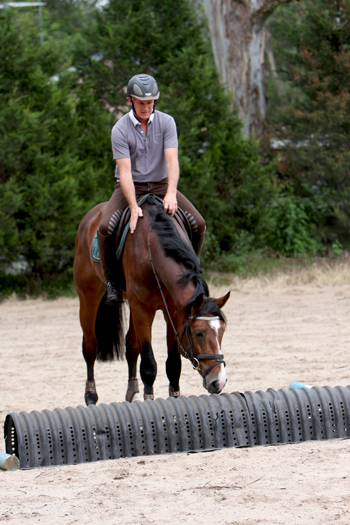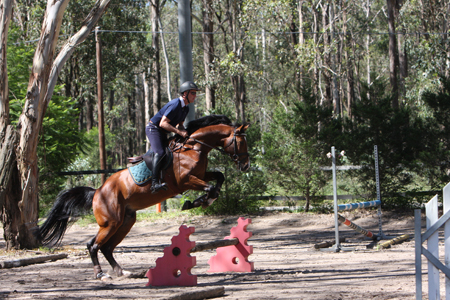Roger Fitzhardinge sits in on a training session with the Chugg’s latest stallion, the Balou du Rouet son, Baluga…
Chris Chugg has produced many many World Cup horses of all sizes, types and breeds, but he seems to have a particular rapport with stallions. I asked him how he approached them with the view to making them serious competitive horses. As a young dude, his first ever great horse would be Sky High, one of many stallions that his mother, Bev, stood.
Then of course there was Vivant, who Chris and his wife, Helen chose in Belgium as a 3 year old colt and between them produced him to represent Australia at the WEG in Kentucky.
Chris and Helen have now purchased Baluga, who is out of a mare by Carismo, a son of the great Calypso II.
Now the stallion is home in NSW at Diamond B stud near Windsor, I was privileged to watch a day in the life of this up-and-coming star.
He is treated in the stables as any other horse, he cross ties to be saddled with geldings and mares around him. He goes out in a yard and has other horses all around him. He has a truly wonderful nature but by the same token, he is a stallion and is respected by all who work near him. Boys are boys and while he is never taken cheaply, he is expected to fit in with the mob.
Chris always leads his stallions in an anti rearing bit and on a 12 foot lead. He prefers to use a cane whip, not a dressage stinging whip, rather one that is firm and gives a thwack rather than a sting.
“Stallions always need to be well mannered and I never let them be disrespectful. I always teach them to wear hopples and tie up with a neck strap to a fixed point, never bailing twine that breaks. At a show they must always be totally under control and secure, and that starts at home. If they are distracted and noisy at a show I will put Vicks Vapour Rub, up their nose to deter them. It is often the smell of mares and other horses that turn those hormones on, so I never go anywhere without Vicks, it really works.
It was time for work for Baluga, or ‘Bob’ as he is known around the stables.
He is only four years old and Chris first works him on the dressage arena. It was interesting to see that there were mares and foals right at the end of the arena and also yards next to them with geldings. Chris believes that they should get used to seeing everything at home that they will encounter out at a competition and they simply learn to cope. Baluga has had 10 mares in the last few weeks and he serves on the property in the round yard and he knows that when he goes to that area it’s for serving and all other times it’s certainly not!
As soon as he hits the dressage arena, Chris gives him a job to do. Simply working trot and plenty of serpentines and changes of direction and always in a steady frame, not too round, but forward to both reins with transitions forward and back, staying steady to the bit all the times. The canter work is more of the same with plenty of smooth developing forward strides and easy collecting strides.
Back to trot, and leg yielding off a circle line, and then off the quarter line – again with the emphasis on smooth balanced transitions within the pace. Even the shoulder in was done in rising trot to keep a steady rhythm and Chris was careful to do the same exercises off both reins.
Chris doesn’t do too much walk early in the session as it’s at the walk that the horse’s mind is easily distracted. He prefers to keep them working till they ask for a break and then it’s a good forward long rein walk, but still attentive to the rider. The work is never seriously disciplined as for show jumping Chris likes to let his stallions think for themselves. He doesn’t want to be so in their face on the flat that when they get to jump their focus is more on the rider than the fence. The rider is there to give confidence and to keep the horse adjustable, but not to the point of total distraction. A showjumping horse needs to use his mind and figure things out, not be always waiting for the rider to do it for them!
Stallions are often gregarious and Chris never discourages playful behavior as long as it is simply expressive exuberance and not undisciplined willful stuff and if is then it’s back to work and there’s nothing like hard work as a distraction!
Bob is amazing for a 4 year old and is always good in the contact and always looking forward and out through the bridle. Chris is very happy with his progress on the flat and would never contemplate jumping a fence without having a good feeling on the flat.
With the flat work done it was up with the stirrups two holes and out of the dressage arena on to the jumping arena, but with all the rain that has fallen recently, there is only one way in – and that’s over a small drain with running water!
It’s walk to the water and let Bob have a good look and a rewarding pat and then come back in a forward canter to the ditch. After a small altercation about staying straight and forward, it’s no problem to pop over the water and onto the arena. Another pat and then it’s forward trot around the fences and serpentines and changes of direction around the various fences.
The dressage arena is the place for the concentration and the jumping arena is the place for the horse to be a little more himself. Chris says: “I give him plenty of latitude and if he has a play, then I am not perturbed by it at all. I don’t discourage it, but if he gets too playful or distracted, then I use the exercises from the dressage arena to gain his concentration again.”
Chris has some trotting poles set out permanently on the arena and uses them to get his horse to start to focus on his job ahead – jumping.
Chris encourages Bob to stretch downwards and out with his nose to look and reach for the rails. The contact is smooth and releasing and the tempo of the trot the same throughout the exercise. It’s important, Chris says, for the stallion to learn to look at the rails and sort out the distances without the rider interfering at all. Approach at trot in balance and tempo, look at the rail, then neck down, wither up and then shoulders and legs up, which is basically the technique he needs to learn to jump well. The most important thing is that he doesn’t rush and learns to take his time and sort out his own balance, distance and focus. Of course it is essential for the rider to also stay in balance, go with the horse and be non-interfering, so as not to distract from the horse’s eye and coordination.
I asked Chris the difference between training stallions to a mare or gelding?
“I like to keep a stallion brave, he always needs to think he can investigate everything. You see a lot of stallions shut down. It’s very important for them to be able to stay brave and confident and never spooky or afraid, and never at any time negative.”
Chris comes to walk and approaches a spooky fence and encourages Bob to take a good look. He takes his time and pats him to reassure him. Chris trots again and practices some leg yielding and transitions within the trot before investigating another fence. It’s into canter and again circles and corners and lines that are exactly where he wants the stallion to be and at his speed. He then comes back to trot and jumps the fences that he had already looked at, from trot.
Why from the trot?
“I am happy to teach all my horses to jump from the trot and to add strides in combinations by trotting in. They look, relax, back up, and peak high and land learning to back up themselves. I call it a working distance. I want to train them to trot to a deep spot and land balanced. Wither up first, then shoulders. It also makes me keep my balance!”
“I am not one for using placing poles as I find it too distracting, and if you get to the pole wrong, then that’s a real mess. It’s much better for the horse to look at the fence and sort it out himself.”
“Vivant was trotting fences right up to WEG, even in the warm up arena in Kentucky. When the horses are enthusiastic and forward, I’d rather trot fences at the beginning, rather than canter and have a battle to be under control after the fence.”
Once the stallion had trotted some fences and remained straight and balanced and confident, then it was on to canter over some cavalettis. And once in canter, Chris doesn’t break up the canter by too many transitions or changes of direction. If he canters a cavaletti off the right rein, then he canters away straight and in the same rhythm on the right lead and then tracks right.
Cavalettis done, and it’s canter to the fences he has jumped from trot – that way Chris is confident that since Bob has already investigated these, he can concentrate on giving the stallion a consistent and easy ride to the fence, making sure that the tempo and speed of the canter is the same on approach as departure.
Chris jumps oxers and verticals and is always totally focused to be dead centre at every fence. “It’s a matter of consistency and form over every fence and to allow the horse to make an honest mistake and learn from his mistake. If he mis-judges the take off point, it’s not a problem, it’s simply a learning experience. He has to learn in training as well as on course. He has to think for himself and never be upset by a mistake, not to lose focus on the next exercise.
Of course some horse’s temperaments deal better than others with this, and there is no question that Baluga is a real thinker and goes about his lesson with a very good attitude and learns from his every jump. Chris always allows him to be happy and playful, that way they are building the future, and keeping the horse bright and fresh.

